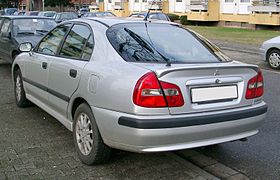Mitsubishi Carisma
| Mitsubishi Carisma | |
|---|---|
 | |
| Overview | |
| Manufacturer | Mitsubishi |
| Production | 1995–2004 |
| Assembly | Born, Netherlands (NedCar) |
| Body and chassis | |
| Class | Large family car |
| Body style | 4-door saloon 5-door hatchback |
| Related | Mitsubishi Space Star Volvo S40 Proton Waja |
| Powertrain | |
| Engine | 1.3 L 4G13 I4 1.6 L 4G92 I4 (DA1) 1.8 L 4G93 I4 (DA2) 1.8 L 4G93 GDI I4 1.9 L F8Q TD I4 1.9 L F9Q DI-D I4 |
| Transmission | 5-speed manual 4-speed auto |
| Dimensions | |
| Wheelbase | 2,550 mm (100.4 in) |
| Length | 4,450 mm (175.2 in) |
| Width | 1,695 mm (66.7 in) |
| Height | 1,405 mm (55.3 in) |
| Curb weight | 1,105–1,180 kg (2,436–2,601 lb) |
| Chronology | |
| Predecessor | Mitsubishi Lancer hatchback(Europe) |
| Successor | Mitsubishi Lancer (Europe) |
The Mitsubishi Carisma is a large family car[1] produced for the European market by Mitsubishi from 1995 to 2004. The model name was derived from a combination of the English car and the Greek kharisma, meaning "divine gift".[2]It was co-developed with Volvo, sharing its chassis with the first generation of the Volvo S40, and built at the NedCarfactory in Born, Netherlands, which the two companies co-owned at the time. Over 350,000 were built during its production run.[3]
Development
Available as a four-door saloon or a five-door hatchback styles only, it featured inline-four gasoline engines from 1.6 L (introduced later in life) to 1.8 L, a 1.8 L gasoline direct injection engine, and 90 hp (67 kW) 1.9 L turbodieselpowerplants sourced from Renault, later with the 100 hp (75 kW) 1.9 DI-D common rail diesel engine, the same as used in both Volvo and Renault cars.
In spite of its name, the Carisma had a fairly neutral design as a result of being Mitsubishi's first attempt to target the traditionally conservative European company car market.[4] Even when receiving a midlife facelift in 1999 that characteristic was not improved. The car underwent a very light redesign again in 2002, with the main difference being the new headlights. The car was placed between the Lancer and the Galant, although after production ended, the Lancer took its place in Mitsubishi's European range.
In several markets where the Lancer was not available, the Evolution version was rebadged as the Mitsubishi Carisma GT. In Japan, the Carisma was sold at a specific retail chain called Car Plaza.
The chassis was also used by Proton to develop the Proton Waja.
Production and sales
| Year | Production | Sales |
|---|---|---|
| 1995 | 19,100 | ? |
| 1996 | 44,401 | ? |
| 1997 | 82,255 | ? |
| 1998 | 78,239 | ? |
| 1999 | 54,460 | ? |
| 2000 | 29,800 | 38,548 |
| 2001 | 22,203 | 28,647 |
| 2002 | 28,776 | 30,429 |
| 2003 | 26,074 | 28,123 |
| 2004 | – | 9,875 |
Gallery
Engines
| Model | Engine | Displacement | Valvetrain | Fuel system | Max. power at rpm | Max. torque at rpm | Years |
|---|---|---|---|---|---|---|---|
| Petrol engines | |||||||
| 1.3 | Mitsubishi 4G13 | 1299 cc | SOHC 16v | Multi-point fuel injection | 60 kW (82 PS; 80 bhp) at 5000 rpm | 120 N·m (89 ft·lbf) at 4000 rpm | 1995–2004 |
| 1.6 | Mitsubishi 4G92 | 1597 cc | SOHC 16v | Multi-point fuel injection | 66 kW (90 PS; 89 bhp) at 5500 rpm | 137 N·m (101 ft·lbf) at 4000 rpm | 1995–1997 |
| 1.6 | Mitsubishi 4G92 | 1597 cc | SOHC 16v | Multi-point fuel injection | 73 kW (99 PS; 98 bhp) at 5750 rpm | 137 N·m (101 ft·lbf) at 4000 rpm | 1997–2000 |
| 1.6 | Mitsubishi 4G92 | 1597 cc | SOHC 16v | Multi-point fuel injection | 76 kW (103 PS; 102 bhp) at 6000 rpm | 141 N·m (104 ft·lbf) at 4500 rpm | 2000–2004 |
| 1.8 | Mitsubishi 4G93 | 1834 cc | SOHC 16v | Multi-point fuel injection | 85 kW (116 PS; 114 bhp) at 5500 rpm | 162 N·m (119 ft·lbf) at 4500 rpm | 1995–1997 |
| 1.8 MSX | Mitsubishi 4G93 | 1834 cc | DOHC 16v | Multi-point fuel injection | 103 kW (140 PS; 138 bhp) at 6500 rpm | 167 N·m (123 ft·lbf) at 5000 rpm | 1995–1997 |
| 1.8 GDI | Mitsubishi 4G93 | 1834 cc | DOHC 16v | Gasoline direct injection | 92 kW (125 PS; 123 bhp) at 5500 rpm | 174 N·m (128 ft·lbf) at 3750 rpm | 1997–2000 |
| 1.8 GDI | Mitsubishi 4G93 | 1834 cc | DOHC 16v | Gasoline direct injection | 90 kW (122 PS; 121 bhp) at 5500 rpm | 174 N·m (128 ft·lbf) at 3750 rpm | 2000–2003 |
| Diesel engines | |||||||
| 1.9 TD | Renault F8QT | 1870 cc | SOHC 8v | Indirect injection | 66 kW (90 PS; 89 bhp) at 4250 rpm | 176 N·m (130 ft·lbf) at 2250 rpm | 1997–2000 |
| 1.9 DI-D MP | Renault F9Q1 | 1870 cc | SOHC 8v | Common rail direct injection | 75 kW (102 PS; 101 bhp) at 4000 rpm | 215 N·m (159 ft·lbf) at 1700 rpm | 2000–2004 |
| 1.9 DI-D HP | Renault F9Q2 | 1870 cc | SOHC 8v | Common rail direct injection | 85 kW (116 PS; 114 bhp) at 4000 rpm | 265 N·m (195 ft·lbf) at 1800 rpm | 2000–2004 |





No comments:
Post a Comment